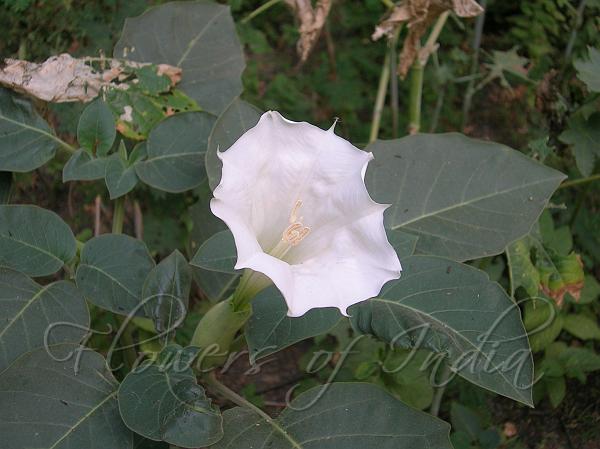|
| Datura |
|

|

| File size | 698349 |
| Original date | 9/7/05 5:04 PM |
| Resolution | 2048 x 1536 |
| Flash | Flash did not fire, auto |
| Focal length | 8.0mm |
| Exposure time | 1/78s |
| Aperture | 3.2 |
| Focus Distance | |
| Metering Mode | Multi-segment |
| Camera make | NIKON |
| Camera model | E3700 |
| Sensor type |
|
|
|
|
Photo: |
Botanical name: Datura innoxia Family: Solanaceae (Potato family)
Synonyms: Datura meteloides, Datura guayaquilensis
Synonyms: Datura meteloides, Datura guayaquilensis
Datura is a perennial or annual shrubby plant that
typically reaches a height of 2-5 ft. Its stems and leaves are covered
with short and soft grayish hairs, giving the whole plant a grayish
appearance. It has ovate to elliptic entire-edged leaves. The flowers
are white, trumpet-shaped, 12-19 cm long. They first grow upright, and
later incline downward. It flowers from early summer until late fall.
The fruit is an egg-shaped spiny capsule, about 5 cm in diameter. It
splits open when ripe, dispersing the seeds. Another means of dispersal
is by the fruit spines getting caught in the fur of animals, who then
carry the fruit far from the mother plant. The seeds have hibernation
capabilities, and can last for years in the soil. The seeds, as well as
the entirety of this plant, act as deliriants, but have a high
probability of overdose. Datura originated in the American Southwest
and Mexico down to Belize and Guatemala. It is now naturalized in
India.
Medicinal uses: In traditional medicine, it is
a reputed drug in the treatment of rabid dog-bites and poisonous insect
bites. The dried leaves and flowering tops are known for their narcotic
and anti-spasmodic properties. They are used for the same purposes as
leaves of belladonna and stramonium.
In traditional medicine, it is
a reputed drug in the treatment of rabid dog-bites and poisonous insect
bites. The dried leaves and flowering tops are known for their narcotic
and anti-spasmodic properties. They are used for the same purposes as
leaves of belladonna and stramonium.
Medicinal uses:
 In traditional medicine, it is
a reputed drug in the treatment of rabid dog-bites and poisonous insect
bites. The dried leaves and flowering tops are known for their narcotic
and anti-spasmodic properties. They are used for the same purposes as
leaves of belladonna and stramonium.
In traditional medicine, it is
a reputed drug in the treatment of rabid dog-bites and poisonous insect
bites. The dried leaves and flowering tops are known for their narcotic
and anti-spasmodic properties. They are used for the same purposes as
leaves of belladonna and stramonium. | Identification credit: Shaista Ahmad | Photographed in Delhi. |
• Is this flower misidentified? If yes,